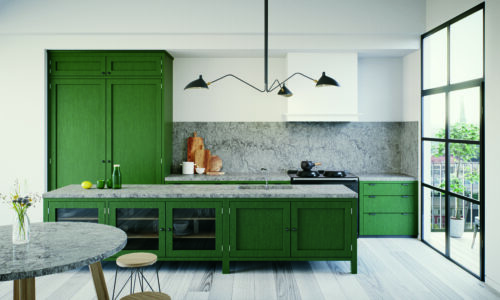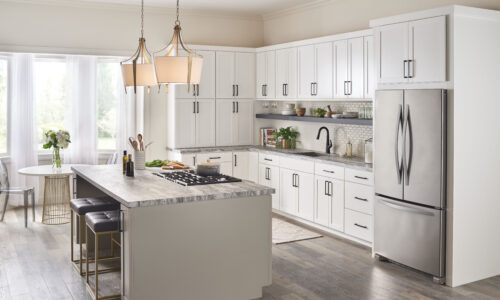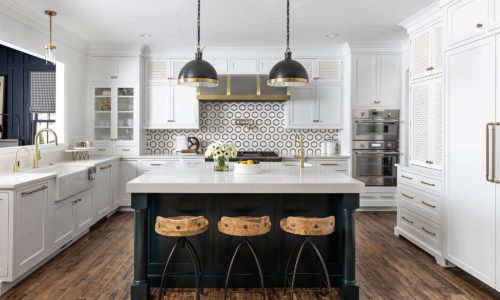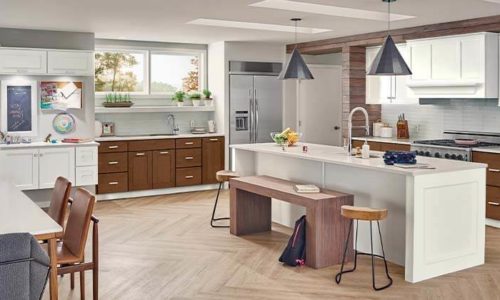7 Features To Consider Before Buying A Gas Grill
May 2, 2023The Bathroom Design Process at Von Tobel
January 19, 2024A Comprehensive Guide to The Kitchen Work Triangle
Efficient Kitchen Design
The concept of the Kitchen Work Triangle is a seemingly simple idea has significantly influenced how we perceive kitchen functionality and design for over half a century.
The Kitchen Work Triangle Explained:
Imagine the relationship between three primary points in a kitchen: the sink, the refrigerator, and the stove. Connect these points mentally, and you form what’s known as the Kitchen Work Triangle.
This design principle arose from the realization that most kitchen tasks involve moving between these three points. The sink is often the starting and finishing point for meal preparation, the refrigerator keeps your ingredients fresh, and the stove is where the actual cooking happens.
When these three points are ideally positioned, it enables smoother, more efficient kitchen work, reducing the steps you take and making meal preparation less tiresome.
The History of the Kitchen Triangle
The concept of the work triangle goes back to the 1940s when a kitchen was a purely functional space. Kitchens then were smaller, and not a place for entertaining or family time. Appliances were a new addition, and the early models were much larger than they are today. The work triangle helped to create a functional flow amidst these circumstances.
Modern-day kitchens are much more advanced than they were in the 1940s, but the work triangle kitchen design has stood the test of time. To this day, it is still a reliable way to layout your kitchen to get the most functional use out of it.
Plus, now that more people move in and out of the family kitchen, the work triangle is a helpful way to manage the flow of traffic. It can also help facilitate multi-purpose kitchens that are serving as homework stations, offices, craft areas and more. When you have a work triangle, you can keep the functional side of the kitchen in one area and have more space to allocate for other uses.
Choose the Best Materials for Your Kitchen Design
Hopefully, you feel inspired to redesign your kitchen to include a work triangle. The tried and true kitchen triangle is a great way to get as much function and efficiency possible from your kitchen design.
Every kitchen remodeling project needs high-quality materials that are both beautiful and high-performing. At Von Tobel, we’ve been providing contractors and homeowners in Indiana with the best supplies for decades.
Our goal is to meet our customer’s needs with high-performance products at a competitive price. Our team of experienced experts can help you choose the right materials for your kitchen.
Contact us today to get started with a free design consultation.
Benefits of the Triangle
-
Firstly, it significantly enhances workflow efficiency. An effective work triangle reduces unnecessary steps between essential areas, saving you time during meal prep.
-
Secondly, it promotes safety. With fewer steps and less clutter, the chances of accidents, like tripping over something left in the walking path, decrease.
-
Lastly, the Kitchen Work Triangle can also lead to cost savings. By identifying the optimal kitchen layout early, you can avoid costly remodeling and repositioning of appliances later on.
Ideal Dimensions of the Work Triangle
The National Kitchen and Bath Association (NKBA) recommends that:
-
each leg of the triangle should be no less than 4′ but no more than 9′
-
the sum of all three legs should be between 13′ and 26′
This ensures that the areas are not too cramped, leading to a crowded kitchen, or too spread out, resulting in unnecessary steps.
Remember that these dimensions are not set in stone. They might vary based on your kitchen’s size, layout, and your personal preference. The key is to find a balance that works best for you, ensuring smooth workflow and comfort.
Impact of Kitchen Size
Kitchen size plays a significant role in designing an efficient work triangle. Smaller kitchens might face challenges with space constraints, requiring creative solutions to keep essential points accessible. It’s about maximizing the use of available space. Consider compact appliances or innovative storage solutions that do not compromise the functionality of the kitchen.
Larger kitchens may have the opposite problem, with the three points being too spread out, leading to excessive movement during meal preparation. Creating auxiliary centers or integrating kitchen islands can help to maintain the efficiency of the work triangle.
Consideration of Household Needs
Your kitchen must serve your specific needs and habits. A vegetarian household, for example, might need a larger prep area for chopping vegetables, which could significantly alter the conventional work triangle.
Family size also influences the design. Larger families might need more refrigeration space or a bigger stove, demanding alterations to the work triangle. Similarly, if your family enjoys entertaining, you might require a larger open area or an additional sink for bar purposes.
Adapting To Various Kitchen Layouts
Designing an efficient work triangle heavily depends on your kitchen layout. Here’s how it can adapt to various layouts:
1. Single Wall Kitchen: In this layout, the work triangle becomes a linear workspace since all appliances are on a single wall. The optimal order would typically be refrigerator, sink, and then stove for most efficient use.
2. Galley Kitchen: With two parallel countertops, the sink and stove are usually on one side with the refrigerator on the other to form a compact and efficient triangle.
3. L-Shaped Kitchen: The triangle forms along the angle of the L, usually with the sink in the corner, flanked by the refrigerator and stove.
4. U-Shaped Kitchen: In this layout, each point of the triangle is typically placed on each leg of the U. The placement of each point can vary based on personal preference.
5. Island Kitchen: In kitchens with an island, one point of the triangle, typically the sink or the stove, is often placed on the island. This layout creates an expansive work triangle.
Challenges in Implementing the Kitchen Work Triangle
While the work triangle is an ideal principle, it’s not always easy to implement perfectly. Space constraints in smaller kitchens can make it hard to keep the points distinct. Budget limitations might also prevent you from repositioning appliances.
Another challenge is integrating modern appliances like dishwashers or microwaves. A potential solution is to consider these as secondary points that form smaller, auxiliary triangles with the main points.
The Work Triangle in Open-Plan Kitchens
Open-plan kitchens present unique design challenges. With no defining walls, the triangle can easily stretch too far, reducing efficiency. One solution is to use kitchen islands or countertops to define the workspace. Consider the flow of your open-plan area to make sure the kitchen doesn’t disturb the living or dining areas.
Technology & Triangle
As technology continues to impact our everyday lives, it is also reshaping our kitchens. The rise of smart appliances and innovative kitchen gadgets can affect the traditional work triangle. A smart refrigerator or an integrated cooking system might alter how you move within your kitchen.
While integrating tech, it’s essential to maintain the efficiency of the work triangle. Keep smart appliances within the existing points or create new auxiliary triangles as necessary.
Universal Design
The universal design aims to create environments that are accessible to all, regardless of age, size, or ability. Consider your family’s varying needs when applying this principle to the kitchen work triangle. For instance, appliances could be placed at more accessible levels, or walkways could be widened to accommodate mobility aids. Adapting the work triangle for different abilities ensures that your kitchen is welcoming and usable for everyone.
Quick Design Tips
Designing your kitchen work triangle can be a fun process, but it’s essential to keep a few things in mind. Avoid placing obstacles like trash bins or islands in the path of the triangle. Put the refrigerator in the most accessible point, as people not involved in cooking often use it. Always remember, the key is to customize the triangle according to your specific needs.
Whether you’re remodeling your kitchen or starting from scratch, considering the work triangle can greatly enhance the efficiency, safety, and overall usability of your kitchen.
Remember, the triangle serves as a guideline. Feel free to adjust and experiment based on your kitchen size, layout, personal habits, and specific needs. With careful planning and a bit of creativity, you can master your kitchen work triangle and create a space that is both beautiful and functional.







